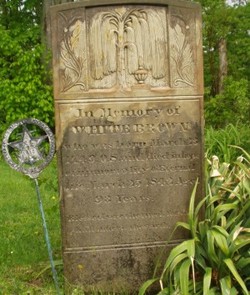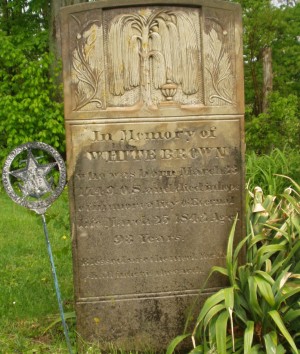He served as a soldier in the Revolution, and was a conspicuous worker in the early history of the Methodist Episcopal Church in America. He visited the Northwest Territory in 1799, and soon after became a permanent settler in Ross County. From a history of Ross County, which, with Highland County, was published in 1880, we quote as follows:
"White Brown, if not actually the first white settler of Deerfield Township, was first in matters of public improvement. He was a man of intelligence and very strong religious belief. He had, in 1781, built a Methodist Meeting House in his native state, it being known as Brown's Chapel. In 1799 he came to the Northwest Territory and explored quite a section including Ross County. In 1801 he returned to Ross County, accompanied by his sons and slaves (forty in number), which he later freed. He bought 500 acres of land in what is now Deerfield Township, which was then an unbroken forest, and pending the time when it should be cleared his sons and negro servants raised a crop of corn on the land now occupied by the Ross County Infirmary. In 1802 he built a log house on his land, and in 1803 the remainder of his family joined him, and in that year he built a commodious log barn. In that building from 1803 until 1818, were held the services of the pioneer Methodist Episcopal Church of Deerfield. His son-in-law, Steven Timmons, was the first to preach there. Later Bishops Francis Asbury, Whatcoat, and McKendry, also George and Lorenzo Dow, and the Finleys, father and son, preached there.
"In 1805 he erected a saw mill on his farm on Deer Creek, it being the first mill in Deerfield Township. He dammed the stream by felling a tree across it and then filling in with brush. He kept the first silver dollar he earned in this mill. It was a Spanish coin and bears the date of 1781. The initials W.H., and the date 1805, are marked on the face, and it is still preserved by the family. In addition to other interests, Mr. Brown engaged in shipping supplies to New Orleans. He was also a member of the first board of township trustees. He was a man of great force of character, well known in his native state as well as in the state of his adoption." He died March 23, 1842, aged ninety-three years. He was three times married, by his first marriage having five daughters, by his second union having a son and a daughter, and by his thrid marriage having three daughters and two sons.
*Copied from History of Ross County, Volume 1, 1917
He served as a soldier in the Revolution, and was a conspicuous worker in the early history of the Methodist Episcopal Church in America. He visited the Northwest Territory in 1799, and soon after became a permanent settler in Ross County. From a history of Ross County, which, with Highland County, was published in 1880, we quote as follows:
"White Brown, if not actually the first white settler of Deerfield Township, was first in matters of public improvement. He was a man of intelligence and very strong religious belief. He had, in 1781, built a Methodist Meeting House in his native state, it being known as Brown's Chapel. In 1799 he came to the Northwest Territory and explored quite a section including Ross County. In 1801 he returned to Ross County, accompanied by his sons and slaves (forty in number), which he later freed. He bought 500 acres of land in what is now Deerfield Township, which was then an unbroken forest, and pending the time when it should be cleared his sons and negro servants raised a crop of corn on the land now occupied by the Ross County Infirmary. In 1802 he built a log house on his land, and in 1803 the remainder of his family joined him, and in that year he built a commodious log barn. In that building from 1803 until 1818, were held the services of the pioneer Methodist Episcopal Church of Deerfield. His son-in-law, Steven Timmons, was the first to preach there. Later Bishops Francis Asbury, Whatcoat, and McKendry, also George and Lorenzo Dow, and the Finleys, father and son, preached there.
"In 1805 he erected a saw mill on his farm on Deer Creek, it being the first mill in Deerfield Township. He dammed the stream by felling a tree across it and then filling in with brush. He kept the first silver dollar he earned in this mill. It was a Spanish coin and bears the date of 1781. The initials W.H., and the date 1805, are marked on the face, and it is still preserved by the family. In addition to other interests, Mr. Brown engaged in shipping supplies to New Orleans. He was also a member of the first board of township trustees. He was a man of great force of character, well known in his native state as well as in the state of his adoption." He died March 23, 1842, aged ninety-three years. He was three times married, by his first marriage having five daughters, by his second union having a son and a daughter, and by his thrid marriage having three daughters and two sons.
*Copied from History of Ross County, Volume 1, 1917
Inscription
93y









